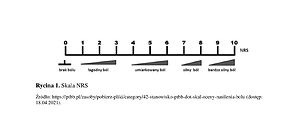RESEARCH PAPER
Back pain in office workers – preliminary study
1
Katedra Zdrowia Populacyjnego, Uniwersytet Medyczny, Wrocław, Polska
2
Student Uniwersytetu Medycznego, Wrocław, Polska
Corresponding author
Med Og Nauk Zdr. 2021;27(4):395-399
KEYWORDS
TOPICS
ABSTRACT
Introduction and objective:
Background: Back pain is particularly common among many chronic pain ailments. This problem mainly affects office workers, due to the long working time daily in a sitting position. The aim of the study was to assess back pain in a group of office workers, as well as to establish the relationship between the intensity and frequency of pain depending on duration of employment and gender.
Material and methods:
The study was conducted using an author constructed questionnaire, and included 120 respondents who met the criteria for inclusion. The NRS scale was used to assess pain intensity.
Results:
In the studied group of office workers pain most frequently occurred in the lumbosacral spine (66.7%), while most rarely in the thoracic section (14.2%). Females and males almost equally often reported pain in all sections of the spine. More than a half of the respondents reported pain while sitting, females more often than males. Over 80% of respondents indicated that back pain has a negative impact on work performance. Less than 30% of the surveyed office workers did not apply the principles of work ergonomics.
Conclusions:
1. Spinal pain symptoms are most often located in the lumbosacral spine, regardless of gender. 2. The frequency and intensity of pain experienced by office workers does not depend on gender. 3. Work experience does not affect the intensity and frequency of occurrence of back pain in office workers. 4. Workshops, instructional videos, training for office workers on the practical application of the principles of work ergonomics should be introduced.
Background: Back pain is particularly common among many chronic pain ailments. This problem mainly affects office workers, due to the long working time daily in a sitting position. The aim of the study was to assess back pain in a group of office workers, as well as to establish the relationship between the intensity and frequency of pain depending on duration of employment and gender.
Material and methods:
The study was conducted using an author constructed questionnaire, and included 120 respondents who met the criteria for inclusion. The NRS scale was used to assess pain intensity.
Results:
In the studied group of office workers pain most frequently occurred in the lumbosacral spine (66.7%), while most rarely in the thoracic section (14.2%). Females and males almost equally often reported pain in all sections of the spine. More than a half of the respondents reported pain while sitting, females more often than males. Over 80% of respondents indicated that back pain has a negative impact on work performance. Less than 30% of the surveyed office workers did not apply the principles of work ergonomics.
Conclusions:
1. Spinal pain symptoms are most often located in the lumbosacral spine, regardless of gender. 2. The frequency and intensity of pain experienced by office workers does not depend on gender. 3. Work experience does not affect the intensity and frequency of occurrence of back pain in office workers. 4. Workshops, instructional videos, training for office workers on the practical application of the principles of work ergonomics should be introduced.
REFERENCES (13)
1.
Hay SI, Vos T, Abajobir AA, et al. Global, regional, and national in-cidence, prevalence, and years lived with disability for 328 diseases and injuries for 195 countries, 1990–2016: a systematic analysis for the Global Burden of Disease Study 2016. Lancet. 2017; 390: 1211–1259.
2.
Dahlhamer J, Lucas J, Zelaya C, et al. Prevalence of Chronic Pain and High-Impact Chronic Pain Among Adults – United States.MMWR.2018; 67: 1001–1006.
3.
Goldberg DS, McGee SJ. Pain as a global public health priority. BMC Public Health.2011; 11: 770.
4.
International Association for the Study of Pain. 2021 Global Year About Back Pain, 2021. In: https://www.iasp-pain.org/Glob... (access: 2021.05.16).
5.
Fundacja Zdrowie Jest Najważniejsze. Kampania edukacyjna „Aktywny kręgosłup“, 2021. In: https://www.aktywnykregoslup.p... = IwA-R3opKbEnYvPYgDfr9hCA8AWOv3ooCZrkxRcm32CZtRmvelQOkRo-POXf4WU (access: 2021.05.16).
6.
Serwis Ministerstwa Zdrowia i Narodowego Funduszu Zdrowia. Ogól-nopolski program profilaktyki przewlekłych bólów kręgosłupa, wrze-sień 2019. In: https://pacjent.gov.pl/program... (access: 2021.05.16).
7.
Polskie Towarzystwo Badania Bólu. Stanowisko PTBB dot. skal oceny nasilenia bólu., grudzień 2018. In: https://ptbb.pl/zasoby/pobierz... (access: 2021.05.16).
8.
Sobolewska P, Szyjka A, Szczepanowska-Wołowiec B, et al. Dolegliwości bólowe kręgosłupa w grupie pracowników biurowych. Ostry Dyżur. 2016; 9(3): 69–72.
9.
Czechowska D, Pałgan M, Bac A. Ocena charakteru pracy oraz dolegliwości bólowych kręgosłupa u pilotów samolotów pasażerskich. Kwart Ortoped. 2010; 3: 334–341.
10.
Kędra A, Kolwicz-Gańko A, Sitkarski D, et al. Bóle odcinka lędźwiowego kręgosłupa a funkcjonowanie studentów w życiu codziennym. Ortop Traumatolog Reh. 2016; 1(6): 31–39.
11.
Mikołajczyk A, Kupcewicz E. Dolegliwości bólowe pleców wśród pa-cjentów podstawowej opieki zdrowotnej. Kwart Ortoped. 2010; 1: 86–93.
12.
Drężewska M, Sieroń A, Śliwiński Z. Ocena efektów analgetycznych terapii wibroakustycznej w leczeniu dolegliwości bólowych części lędźwiowo-krzyżowej kręgosłupa u pracowników biurowych. Fizjoter Pol. 2013; 13: 8–13.
13.
Augustyniuk K, Leśniak A, Szkup M, et al. Występowanie dolegliwości bólowych kręgosłupa wśród pracowników sektora handlowego. Forum Med Rodz. 2016; 10(2): 95–98.
Share
RELATED ARTICLE
We process personal data collected when visiting the website. The function of obtaining information about users and their behavior is carried out by voluntarily entered information in forms and saving cookies in end devices. Data, including cookies, are used to provide services, improve the user experience and to analyze the traffic in accordance with the Privacy policy. Data are also collected and processed by Google Analytics tool (more).
You can change cookies settings in your browser. Restricted use of cookies in the browser configuration may affect some functionalities of the website.
You can change cookies settings in your browser. Restricted use of cookies in the browser configuration may affect some functionalities of the website.



